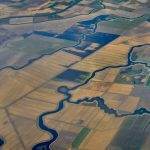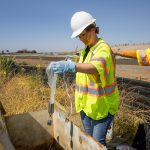- Scientists have developed a new AI system capable of predicting river flow nationwide.
- The tool combines physics with deep learning for greater accuracy.
- Researchers say it could transform how floods and droughts are forecast.
Wednesday, October 15, 2025 — A team led by Clemson University, with collaborators from Cardiff University and the IHE Delft Institute for Water Education, has developed a new artificial intelligence system that predicts how rainfall becomes river flow across the continental United States. Published in Water Resources Research on October 10, 2025, the study represents one of the first large-scale efforts to combine physical watershed science with deep-learning models.
Instead of treating rivers as black boxes, the team taught AI to “think” more like a hydrologist—using known physical laws as guideposts. This hybrid approach, called physics-guided deep learning, produced a model that not only improved forecast accuracy but also explained why certain predictions occurred.
Two AI Models: DeepAR and Temporal Fusion Transformer.
The research focused on two AI methods. The first, called DeepAR, was originally developed by Amazon and uses recurrent neural networks to recognize time-based patterns. The second, Google’s Temporal Fusion Transformer (TFT), uses an “attention” mechanism that helps it prioritize the most relevant data—much like how the human brain focuses on important cues.
focused on two AI methods. The first, called DeepAR, was originally developed by Amazon and uses recurrent neural networks to recognize time-based patterns. The second, Google’s Temporal Fusion Transformer (TFT), uses an “attention” mechanism that helps it prioritize the most relevant data—much like how the human brain focuses on important cues.
Researchers adapted both tools for hydrology, feeding them 30 years of rainfall, temperature, and soil data from 531 watersheds. They also taught the models physical details about each basin—such as slope, soil depth, and vegetation type—so the AI could understand how geography affects water flow.
When tested, the physics-guided versions of both DeepAR and TFT outperformed traditional hydrologic models, such as the Sacramento Soil Moisture Accounting Model and the Variable Infiltration Capacity model, which have long been standards in the field.
Explaining the “Why” Behind River Behavior.
A central goal of the study was interpretability—understanding how AI reaches its conclusions. “Traditional hydrologic models often struggle with complex watershed behaviors,” said Dr. Vidya Samadi , the study’s lead author. “By embedding physical constraints into AI, we created models that perform better and explain their reasoning.”
, the study’s lead author. “By embedding physical constraints into AI, we created models that perform better and explain their reasoning.”
The transformer model, in particular, highlighted which environmental factors most influenced daily streamflow—offering transparency rarely seen in machine-learning applications. This kind of interpretability is crucial when forecasts are used to manage water supplies or plan for floods.
Toward Smarter Climate Resilience.
Beyond improving forecasts, the AI’s predictive range can help planners identify vulnerabilities in water systems, assess drought impacts, and estimate the likelihood of extreme events. Co-author Professor Catherine Wilson of Cardiff University said the system “helps scientists and water managers trust AI predictions and use them with confidence to manage critical water resources.”
The team plans to expand the model to include variables such as soil moisture, land use change, and future climate projections. With continued refinement, it could become a core tool for building climate resilience in both local and national water management.
Citation:
, , , & (2025). Probabilistic physics-guided deep neural networks with recurrence and attention mechanisms for interpretable daily streamflow simulation. Water Resources Research, 61, e2025WR040173. https://doi.org/10.1029/2025WR040173
FAQ
Q: How is this different from traditional river models?
Traditional models rely on equations built from field measurements and assumptions about soil and weather. The new AI model learns directly from data—then uses physics-based rules to keep its predictions realistic.
Q: What does “physics-guided” mean?
It means the AI isn’t allowed to make predictions that break natural laws like water balance. The algorithms are trained with real hydrological principles built into their design.
Q: Why does interpretability matter?
Because agencies and scientists need to understand why a model predicts a flood or drought before acting on it. A transparent AI model can explain which factors—rainfall, soil, or temperature—drove its result.
Q: Could this be used beyond the United States?
Yes. The approach is adaptable worldwide, wherever long-term rainfall and river data are available.
Q: How might it help ordinary people?
Better forecasts could mean earlier flood warnings, smarter irrigation planning, and improved drinking-water protection during drought years.





